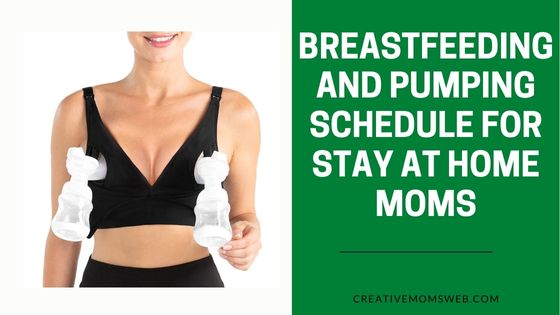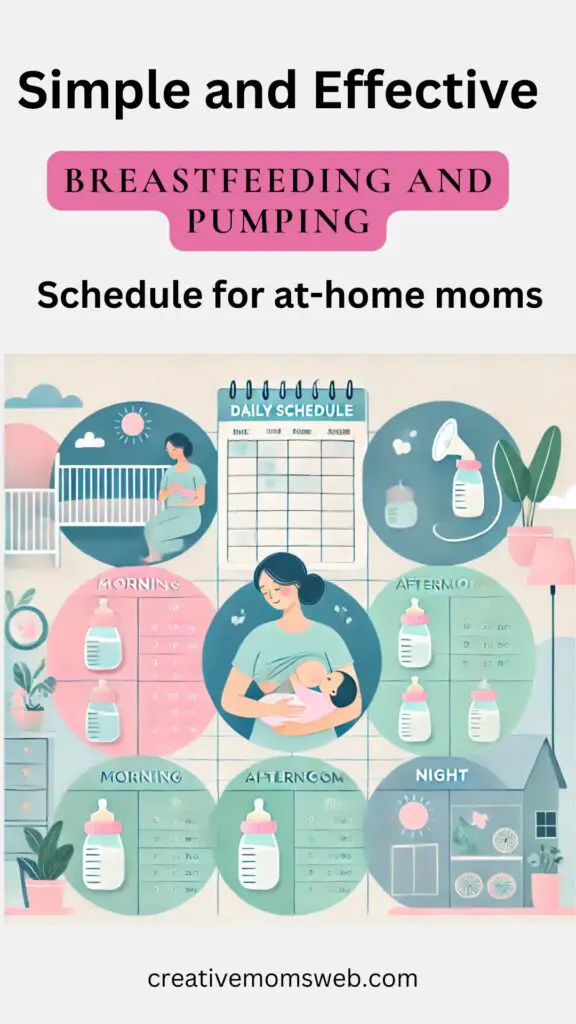As a stay-at-home mom who exclusively breastfeeds, you may find that you need to pump on occasion. However, it’s important to set up a good breastfeeding and pumping routine that works for you and your baby. This will help ensure that your baby is getting enough nutrition while also allowing you to get the rest you need. In this article, we’ll discuss how to create an effective breastfeeding and pumping schedule for stay-at-home moms. We’ll cover topics such as how often you should feed your baby when it’s best to pump and tips for making sure you stick with your routine.

Why stay-at-home mom pumps
Here are five reasons why stay-at-home moms pump:
- Take a break
As a mom, there are times when you want to run errands, sleep, have “me time“, or hang out with other moms. Having enough milk in the freezer is important because you can delegate feeding your baby to the father, ensuring that your baby receives adequate nutrition while you rest.
- Medical emergencies
As a stay-at-home mom, you may face unexpected medical emergencies. Pumping milk can be a great way to ensure that your little one will always have access to the nutrition they need, even in case of medical emergencies.
- Pumping help increase the milk supply
If a lack of milk supply is an issue, pumping will help increase the milk supply.
- Pumping can help reduce engorgement
Pumping can help reduce engorgement by expressing excess milk and relieving pressure on the breasts.
- The best alternative when introducing solid food to your baby
When it comes to introducing solid food to your baby, you can mix mashed vegetables, smoothies, and cereals with breast milk which is the best alternative to goat or cow milk.
- It can provide an additional source of income by donating milk;
Milk pumping is becoming a popular way for mothers to make money while caring for their babies. It can provide an additional source of income by donating milk, which can be sold to hospitals, research facilities, and other organizations.
There are milk banks that pay donors such as Tiny Treasures Milk Bank will pay you $1.10 per ounce. You can also check with Helping Hands Milk Bank.
- Help others
If you have extra breast milk, you can donate it to another mother who is suffering from a medical condition. There are also cases where a mother dies leaving an infant, and you can assist in such cases.
How much milk do you need to pump
It is always advisable to have one week’s worth in your freezer and will help the caregiver find a solution if necessary.
Creating a Breastfeeding and pumping schedule for stay-at-home moms
Before you start creating a breastfeeding and pumping schedule it is important you understand how much milk you need. If you need milk for only that day pumping once a day is enough but for the larger stock, you need to pump more than three times per day.
Also, you need to figure out when you produce more milk. Some mom produces more milk in the morning and others when they are breastfeeding.
Best time to pump
Here are the options when is the best time to pump
When the baby is breastfeeding
You can pump on one side while your baby is nursing on the other.
After the baby has breastfed
You pump immediately after your baby has breastfed. This works best in the morning if you produce more milk in the morning. In the case, your baby spends most of the night breastfeeding this is not the case.
You can decide to pump between feedings if you wait 30 minutes after breastfeeding.
Guide to help you through creating an effective breastfeeding and pumping schedule tailored for stay-at-home moms.
- Establish a Solid Foundation:
In the early weeks after giving birth, it’s essential to establish a strong breastfeeding relationship with your baby. Breastfeed on demand, allowing your baby to nurse whenever they show hunger cues. This will help build up your milk supply and ensure your baby’s nutritional needs are met.
- Introduce Pumping Sessions:
Once breastfeeding is well-established, you can gradually introduce pumping sessions into your routine. Start by pumping once a day, preferably in the morning when the milk supply tends to be higher. This will help you build up a stash of breast milk and allow your baby to become accustomed to bottle feeding.
- Determine Your Pumping Goals:
Consider why you want to incorporate pumping into your routine. Are you building a freezer stash for future use, preparing for your return to work, or allowing your partner to participate in feeding? Understanding your goals will help you determine the frequency and duration of your pumping sessions.
- Find Your Pumping Schedule:
Every mom and baby duo is unique, so finding a pumping schedule that works for you is crucial. Experiment with different times of day and pumping frequencies to discover what suits your needs best. Some moms find it helpful to pump after breastfeeding, while others prefer pumping between feedings. Listen to your body’s cues and adjust the schedule accordingly.
- Consider Baby’s Feeding Patterns:
Observe your baby’s natural feeding patterns to plan your pumping sessions. If your baby typically feeds every two to three hours, you can plan to pump shortly before or after each feeding session to maintain a consistent milk supply and prevent engorgement.
- Utilize Power Pumping:
If you’re looking to increase your milk supply or build up a stash, incorporate power pumping into your schedule. Power pumping involves pumping for short intervals with breaks in between to mimic cluster feeding. This technique can help stimulate your breasts and signal your body to produce more milk.
- Involve Your Partner or Support System:
One of the advantages of pumping is that it allows your partner or other family members to participate in feeding your baby. Coordinate with your partner to determine the best time for them to take over a feeding session using the pumped milk. This not only provides you with a break but also strengthens your bond with the baby.
- Maintain a Pumping Log:
Keeping a record of your pumping sessions can help you track your milk supply, monitor any changes, and ensure you’re maintaining a consistent pumping schedule. Note the date, time, duration, and amount of milk pumped during each session. This log can also be useful for communicating with healthcare professionals if any concerns arise.
- Self-Care and Nourishment:
Remember to prioritize self-care and nourishment during your breastfeeding and pumping journey. Stay hydrated, eat a balanced diet, and get sufficient rest. Incorporate relaxation techniques during pumping sessions, such as deep breathing or listening to calming music. Taking care of yourself will help optimize your milk production and overall well-being.
Example of the breastfeeding and pumping schedule for stay-at-home moms
5:00 am– Breastfeed then pump (20 minutes)
8:00 – Breastfeed
11:00 – Breastfeed
1:00 – Breastfeed
2:30 – Pump (20 minutes)-when your baby is napping
4:00 – Breastfeed
7:00 – Breastfeed
+1 to 3-night feedings
Essential Supplies Stay-at-Home Moms needs for an Effective Breastfeeding & Pumping Routine
Setting up an effective breastfeeding and pumping routine is crucial for stay-at-home moms who want to ensure their baby is well-fed while also managing other responsibilities. Having the right supplies can make this process smoother and more comfortable. Here are some essential items from Amazon that can help:
1. Breast Pump
- Medela Pump in Style with MaxFlow Breast Pump: This double electric breast pump is highly efficient, offering a strong suction to mimic a baby’s natural feeding pattern. It’s portable and easy to use, making it a popular choice among many moms.
- Spectra S1 Plus Electric Breast Pump: Another great option, especially for those who prefer a quieter pump. It has a rechargeable battery, so you can pump anywhere without worrying about finding an outlet.
2. Breast Milk Storage Bags
- Lansinoh Breastmilk Storage Bags: These are durable and designed for freezing and storing breast milk. They come pre-sterilized with a secure double zipper seal to prevent leaks.
- Medela Breast Milk Storage Bags: Known for their easy-to-pour design and self-standing feature, these bags are another excellent choice for storing your milk.
3. Nursing Bras
- HOFISH 3 Pack Full Bust Seamless Nursing Maternity Bras: These bras offer comfort and easy access for breastfeeding and pumping. They provide good support while being gentle on sensitive skin.
- BRAVADO! Designs Women’s Original Full Cup Nursing Bra: A versatile option that offers comfort for both day and night, with easy one-hand access clips for feeding.
4. Nursing Pads
- Bamboobies Nursing Pads: These washable and reusable pads are eco-friendly and absorbent, perfect for preventing leaks. They’re soft on the skin and easy to wash.
- Lansinoh Stay Dry Disposable Nursing Pads: For those who prefer disposable options, these pads offer excellent absorption and a comfortable fit, keeping you dry throughout the day.
5. Nipple Cream
- Lansinoh Lanolin Nipple Cream: An essential for soothing sore and cracked nipples, this lanolin cream is safe for baby and doesn’t need to be wiped off before breastfeeding.
- Earth Mama Organic Nipple Butter: A natural, lanolin-free option that provides relief for sore nipples and is safe for both mom and baby.
6. Hands-Free Pumping Bra
- Simple Wishes Signature Hands-Free Breast Pump Bra: This bra allows you to pump hands-free, making it easier to multitask while pumping. It’s adjustable and fits all breast pumps.
- Medela Easy Expression Bustier: Compatible with most electric breast pumps, this bustier allows you to pump hands-free, making the process more convenient.
7. Breastfeeding Pillow
- Boppy Nursing Pillow and Positioner: This versatile pillow helps position the baby comfortably during breastfeeding, reducing strain on your back and arms.
- My Brest Friend Original Nursing Posture Pillow: Designed to provide support and maintain a proper position, this pillow is excellent for longer feeding sessions.
8. Bottle Sterilizer
- Philips AVENT Microwave Steam Sterilizer: This sterilizer is compact and effective, sterilizing bottles, breast pump parts, and other baby items in just a few minutes.
- Dr. Brown’s Deluxe Bottle Sterilizer: A larger option that holds more bottles and accessories, ensuring everything is sterilized quickly and efficiently.
9. Breast Milk Cooler Bag
- Sarah Wells Breast Pump Bag: Designed to store breast milk safely while on the go, this bag can keep milk cool for up to 6 hours with an ice pack.
- Medela Breast Milk Cooler and Transport Set: Includes a cooler bag, a contoured ice pack, and four bottles, making it easy to transport milk safely.
10. Nursing Cover
- Bebe Au Lait Premium Cotton Nursing Cover: This stylish nursing cover provides privacy while breastfeeding in public. It has a rigid neckline that allows you to maintain eye contact with your baby.
- Kids N’ Such 4-in-1 Nursing Cover: Multifunctional, this cover can also be used as a car seat cover, shopping cart cover, or scarf, offering versatility and comfort.
Final Thoughts
With these supplies, you can create a breastfeeding and pumping routine that works for you and your baby. These products can help you feel more organized, comfortable, and confident as you navigate the demands of being a stay-at-home mom while ensuring your little one gets the nourishment they need. All these items are available on Amazon, making it convenient to get everything you need delivered right to your doorstep.

Read more stay at home moms’ schedule
